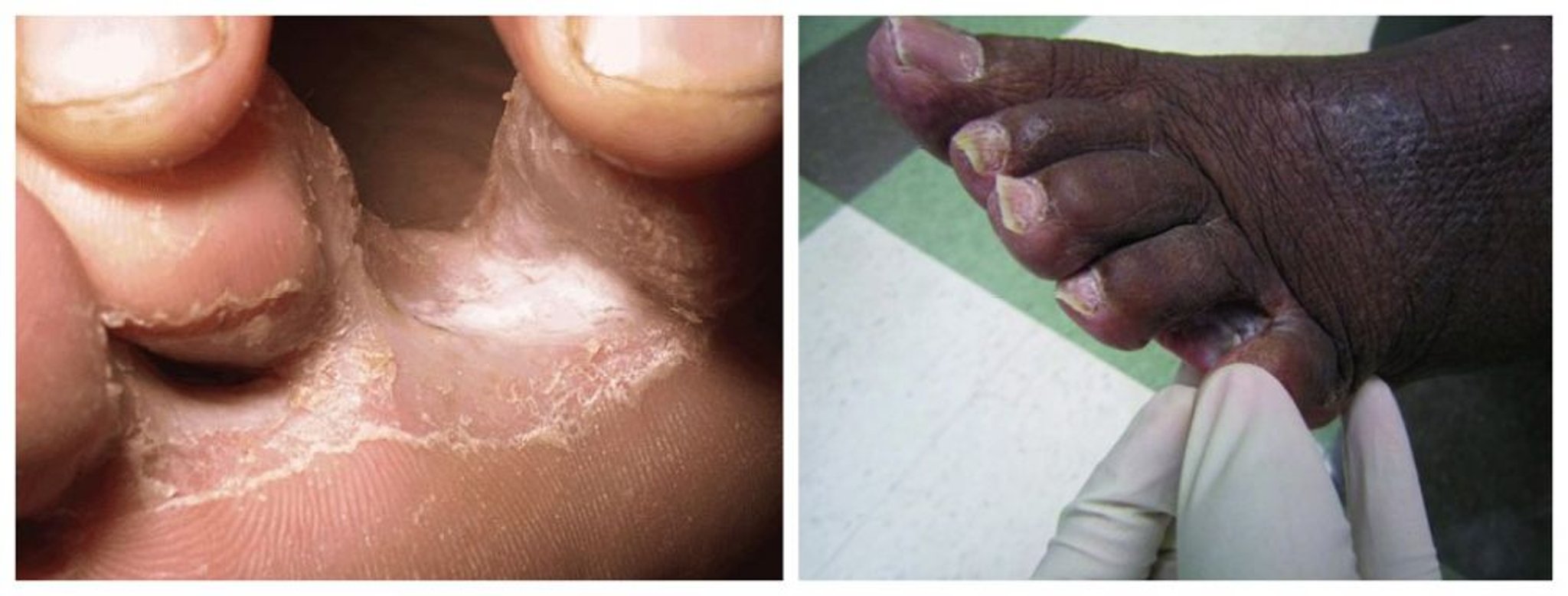Symptoms of tinea pedis include a build up of scale on the feet and sometimes redness and itching.
Doctors base the diagnosis on an examination of the feet.
Treatment includes antifungal medications applied directly to the affected areas or occasionally taken by mouth and measures to keep the feet dry.
Image provided by Thomas Habif, MD.
Tinea pedis is the most common dermatophytosis because foot sweating results in accumulation of moisture in the warm areas between the toes that allows fungi to grow. The infection may spread from person to person in communal showers and bathrooms or in other moist areas where infected people walk barefoot. People who wear tight shoes are also at risk. The infection is usually caused by the fungus Trichophyton.
(See also Overview of Fungal Skin Infections.)
Symptoms of Athlete's Foot
Image provided by Thomas Habif, MD.
© Springer Science+Business Media
The fungus can cause mild scaling with or without redness and itching. The scaling may involve a small area (particularly between the toes) or the entire sole of the foot. Sometimes scaling is severe, with breakdown and painful cracking (fissuring) of the skin. Fluid-filled blisters can also form. Over time, the skin on the soles may thicken.
Because the fungus may cause the skin to crack, tinea pedis can lead to bacterial infections, especially in older adults and in people with inadequate blood flow to the feet.
Diagnosis of Athlete's Foot
A doctor's examination of the feet
Sometimes examination of a skin scraping
The diagnosis of tinea pedis is usually obvious to doctors based on symptoms and the appearance of the affected area.
If the diagnosis is not obvious, doctors do a skin scraping and examine it under a microscope.
Treatment of Athlete's Foot
Antifungal medications applied to the skin or occasionally taken by mouth
Measures to keep the feet dry
The safest treatment of tinea pedis is using antifungal medications that are applied directly to the affected area (topical). However, tinea pedis commonly recurs, and people often have to use antifungal medications for a long time. Antifungal medications taken by mouth (oral), such as itraconazole and terbinafine, are effective but may have side effects. In some situations, topical and oral antifungal medications are used at the same time.The safest treatment of tinea pedis is using antifungal medications that are applied directly to the affected area (topical). However, tinea pedis commonly recurs, and people often have to use antifungal medications for a long time. Antifungal medications taken by mouth (oral), such as itraconazole and terbinafine, are effective but may have side effects. In some situations, topical and oral antifungal medications are used at the same time.
Reducing moisture on the feet and in footwear helps prevent recurrences. Wearing open-toe shoes or shoes that “breathe” and frequently changing socks are important, especially during warm weather. Spaces between toes should be thoroughly towel-dried after bathing. To help keep the feet dry, people may apply antifungal powders (such as miconazole), gentian violet, or aluminum chloride solution or soak their feet in Burow solution (aluminum subacetate). (See also table Reducing moisture on the feet and in footwear helps prevent recurrences. Wearing open-toe shoes or shoes that “breathe” and frequently changing socks are important, especially during warm weather. Spaces between toes should be thoroughly towel-dried after bathing. To help keep the feet dry, people may apply antifungal powders (such as miconazole), gentian violet, or aluminum chloride solution or soak their feet in Burow solution (aluminum subacetate). (See also tableSome Antifungal Medications Applied to the Skin (Topical Medications).)
Drugs Mentioned In This Article





